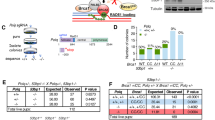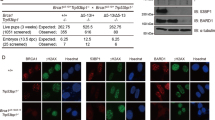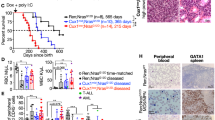Abstract
Ku80 maintains the genome by repairing DNA double-strand breaks (DSBs) through nonhomologous end joining (NHEJ), a pathway that repairs nonspecific DSBs and Rag-1 Rag-2 (Rag)-specific DSBs. As a result, Ku80 deletion results in phenotypes characteristic of defective repair for both nonspecific DSBs (γ-radiation hypersensitivity and genomic instability) and Rag-specific DSBs (immunodeficiency). ku80−/− mice also exhibit neuronal apoptosis, but we do not know the type of DSBs responsible for this response. In spite of genomic instability and immunodeficiency, cancer incidence is not increased in ku80−/− mice. However, deletion of the tumor suppressor, p53 greatly increases pro-B-cell lymphoma in ku80−/− mice due to IgH/c-Myc translocations suggesting that responses to Rag-specific DNA DSBs suppress cancer. Like suppression of pro-B-cell lymphoma, neuronal apoptosis requires p53 presenting the intriguing possibility that Rag-specific DSBs mediate neuronal development as they do lymphocyte development. Here we delete Rag-1 from ku80−/−p53−/− mice to differentiate the impact nonspecific vs Rag-specific DSBs have on ku80−/− mice. We find that deleting Rag-1 prevents pro-B cell lymphoma confirming Rag-induced DSBs induce this form of cancer. Both the triple mutant mice and the p53−/−rag-1−/− mice exhibit T-cell lymphoma and medulloblastoma; incidence of T-cell lymphoma is the same for both cohorts whereas incidence of medulloblastoma is higher for the triple-mutant cohort. Thus, p53-mediated neuronal apoptosis likely suppresses medulloblastoma in Ku80-deleted mice and Ku80 likely suppresses medulloblastoma by repairing nonspecific DNA DSBs instead of Rag-specific DSBs. Our observations are the first to show that Ku80 suppresses cancer caused by nonspecific DNA damage and we present a novel mouse model for medulloblastoma.
This is a preview of subscription content, access via your institution
Access options
Subscribe to this journal
Receive 50 print issues and online access
$259.00 per year
only $5.18 per issue
Buy this article
- Purchase on Springer Link
- Instant access to full article PDF
Prices may be subject to local taxes which are calculated during checkout




Similar content being viewed by others
References
Agrawal A, Eastman QM, Schatz DG . (1998). Nature 394: 744–751.
Ahnesorg P, Smith P, Jackson SP . (2006). Cell 124: 301–313.
Buck D, Malivert L, de Chasseval R, Barraud A, Fondaneche MC, Sanal O et al. (2006). Cell 124: 287–299.
Chun JJ, Schatz DG, Oettinger MA, Jaenisch R, Baltimore D . (1991). Cell 64: 189–200.
Daniel R, Katz RA, Skalka AM . (1999). Science 284: 644–647.
Difilippantonio MJ, Petersen S, Chen HT, Johnson R, Jasin M, Kanaar R et al. (2002). J Exp Med 196: 469–480.
Difilippantonio MJ, Zhu J, Chen HT, Meffre E, Nussenzweig MC, Max EE et al. (2000). Nature 404: 510–514.
Dolle ME, Snyder WK, Gossen JA, Lohman PH, Vijg J . (2000). Proc Natl Acad Sci USA 97: 8403–8408.
Donehower LA, Harvey M, Slagle BL, McArthur MJ, Montgomery Jr CA, Butel JS et al. (1992). Nature 356: 215–221.
Ferguson DO, Sekiguchi JM, Chang S, Frank KM, Gao Y, DePinho RA et al. (2000). Proc Natl Acad Sci USA 97: 6630–6633.
Frank KM, Sekiguchi JM, Seidl KJ, Swat W, Rathbun GA, Cheng HL et al. (1998). Nature 396: 173–177.
Frank KM, Sharpless NE, Gao Y, Sekiguchi JM, Ferguson DO, Zhu C et al. (2000). Mol Cell 5: 993–1002.
Gao Y, Ferguson DO, Xie W, Manis JP, Sekiguchi J, Frank KM et al. (2000). Nature 404: 897–900.
Gao Y, Sun Y, Frank KM, Dikkes P, Fujiwara Y, Seidl KJ et al. (1998). Cell 95: 891–902.
Gladdy RA, Taylor MD, Williams CJ, Grandal I, Karaskova J, Squire JA et al. (2003). Cancer Cell 3: 37–50.
Gu Y, Jin S, Gao Y, Weaver DT, Alt FW . (1997a). Proc Natl Acad Sci USA 94: 8076–8081.
Gu Y, Seidl KJ, Rathbun GA, Zhu C, Manis JP, van der Stoep N et al. (1997b). Immunity 7: 653–665.
Gu Y, Sekiguchi J, Gao Y, Dikkes P, Frank K, Ferguson D et al. (2000). Proc Natl Acad Sci USA 97: 2668–2673.
Guidos CJ, Williams CJ, Grandal I, Knowles G, Huang MT, Danska JS . (1996). Genes Dev 10: 2038–2054.
Hiom K, Melek M, Gellert M . (1998). Cell 94: 463–470.
Hoeijmakers JH . (2001). Nature 411: 366–374.
Karanjawala ZE, Adachi N, Irvine RA, Oh EK, Shibata D, Schwarz K et al. (2002). DNA Repair (Amsterdam) 1: 1017–1026.
Karanjawala ZE, Grawunder U, Hsieh CL, Lieber MR . (1999). Curr Biol 9: 1501–1504.
Lee CJ, Chan WI, Scotting PJ . (2005). J Neurooncol 73: 101–108.
Lee Y, McKinnon PJ . (2002). Cancer Res 62: 6395–6399.
Liao MJ, Zhang XX, Hill R, Gao J, Qumsiyeh MB, Nichols W et al. (1998). Mol Cell Biol 18: 3495–3501.
Lieber MR, Ma Y, Pannicke U, Schwarz K . (2004). DNA Repair (Amsterdam) 3: 817–826.
Lim DS, Vogel H, Willerford DM, Sands AT, Platt KA, Hasty P . (2000). Mol Cell Biol 20: 3772–3780.
Lin W, Kemper A, McCarthy KD, Pytel P, Wang JP, Campbell IL et al. (2004). J Neurosci 24: 10074–10083.
Marino S . (2005). Trends Mol Med 11: 17–22.
Maser RS, DePinho RA . (2003). Cancer Cell 3: 4–6.
Mombaerts P, Iacomini J, Johnson RS, Herrup K, Tonegawa S, Papaioannou VE . (1992). Cell 68: 869–877.
Muotri AR, Chu VT, Marchetto MC, Deng W, Moran JV, Gage FH . (2005). Nature 435: 903–910.
Nacht M, Jacks T . (1998). Cell Growth Differ 9: 131–138.
Nussenzweig A, Chen C, da Costa Soares V, Sanchez M, Sokol K, Nussenzweig MC et al. (1996). Nature 382: 551–555.
Nussenzweig A, Sokol K, Burgman P, Li L, Li GC . (1997). Proc Natl Acad Sci USA 94: 13588–13593.
Oettinger MA, Schatz DG, Gorka C, Baltimore D . (1990). Science 248: 1517–1523.
Raghavan SC, Hsieh CL, Lieber MR . (2005a). Mol Cell Biol 25: 6475–6484.
Raghavan SC, Swanson PC, Ma Y, Lieber MR . (2005b). Mol Cell Biol 25: 5904–5919.
Raghavan SC, Swanson PC, Wu X, Hsieh CL, Lieber MR . (2004). Nature 428: 88–93.
Roth DB, Craig NL . (1998). Cell 94: 411–414.
Schatz DG, Oettinger MA, Baltimore D . (1989). Cell 59: 1035–1048.
Vanasse GJ, Halbrook J, Thomas S, Burgess A, Hoekstra MF, Disteche CM et al. (1999). J Clin Invest 103: 1669–1675.
Vogel H, Lim DS, Karsenty G, Finegold M, Hasty P . (1999). Proc Natl Acad Sci USA 96: 10770–10775.
Zhu C, Bogue MA, Lim DS, Hasty P, Roth DB . (1996). Cell 86: 379–389.
Zhu C, Mills KD, Ferguson DO, Lee C, Manis J, Fleming J et al. (2002). Cell 109: 811–821.
Acknowledgements
We thank Mr Gary Chisholm for statistical analysis and Ms Charnae Williams for technical assistance. This work was supported by Grants NIH P01 AG17242 and R01 CA76317-05A1 to PH and DOD W81XWH-04-1-0325 to VBH.
Author information
Authors and Affiliations
Corresponding author
Rights and permissions
About this article
Cite this article
Holcomb, V., Vogel, H., Marple, T. et al. Ku80 and p53 suppress medulloblastoma that arise independent of Rag-1-induced DSBs. Oncogene 25, 7159–7165 (2006). https://doi.org/10.1038/sj.onc.1209704
Received:
Revised:
Accepted:
Published:
Issue Date:
DOI: https://doi.org/10.1038/sj.onc.1209704
Keywords
This article is cited by
-
Medulloblastoma: experimental models and reality
Acta Neuropathologica (2017)
-
Bax deficiency extends the survival of Ku70 knockout mice that develop lung and heart diseases
Cell Death & Disease (2015)
-
Opposite modifying effects of HR and NHEJ deficiency on cancer risk in Ptc1 heterozygous mouse cerebellum
Oncogene (2011)
-
Deleting Ku70 is milder than deleting Ku80 in p53-mutant mice and cells
Oncogene (2009)
-
Cellular senescence and organismal ageing in the absence of p21CIP1/WAF1 in ku80−/− mice
EMBO reports (2009)



